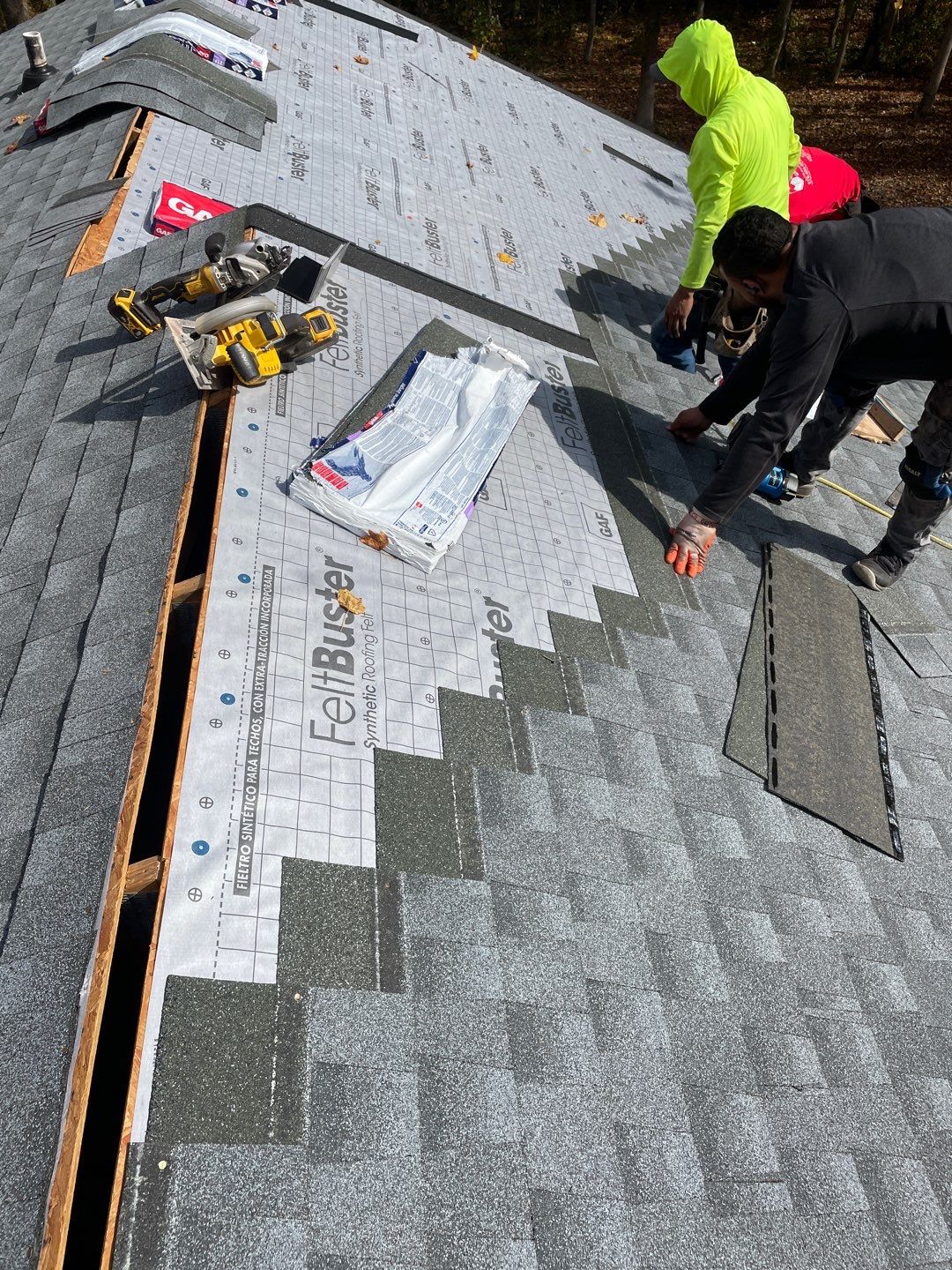The Benefits of Dealing With Gainesville FL Roofing Companies
The Benefits of Dealing With Gainesville FL Roofing Companies
Blog Article
Ideal Practices for Ensuring Correct Roof Covering Air Flow
Making sure proper roofing ventilation is essential for the longevity and performance of a roof. A balanced consumption and exhaust air vent ratio, commonly 1:300, plays an essential duty, with consumption vents preferably positioned at the reduced edge of the roofing system for great air entrance and exhaust vents at the optimal for cozy air departure. Routine inspections to identify clogs and maintain clear air movement are vital. Additionally, maintaining insulation far from vents is critical to avoid air flow restriction. Comprehending these foundational components sets the stage for even more detailed understandings right into installment and upkeep practices that can substantially improve your roof system's efficiency.
Understand Air Flow Fundamentals
Properly recognizing ventilation essentials is necessary for making certain the long life and efficiency of roof. Reliable air flow minimizes dampness accumulation and temperature level extremes in the attic, both of which can bring about substantial architectural damages over time. A well-ventilated roof covering aids in protecting against typical concerns such as mold and mildew development, timber rot, and ice dams, which can compromise the honesty of the roofing products and the underlying frameworks.
The primary objective of ventilation is to promote the activity of air, permitting for a consistent exchange in between the interior and outside settings. This equilibrium is achieved via a combination of intake and exhaust vents that interact to maintain optimum airflow. Intake vents, normally situated along the soffits or eaves, allow fresh air to go into the attic room, while exhaust vents, usually positioned at or near the roof covering ridge, enable warm, moist air to escape.
Secret aspects influencing the performance of roof covering air flow include appropriate positioning, appropriate sizing, and making sure that both consumption and exhaust vents are unhampered. Routine examination and upkeep are crucial to recognize prospective obstructions, damage, or inefficiencies in the air flow system, therefore protecting the roofing system's performance and toughness.
Sorts Of Roofing System Vents
Roof vents play a crucial role in maintaining effective attic ventilation and, by extension, the general health and wellness of the roof covering system. Different types of roof vents are readily available, each with unique advantages tailored to particular roofing requirements.

Soffit vents are set up under the eaves and job in tandem with roofing system vents to make certain a balanced intake and exhaust system. By enabling cooler air to enter from below, soffit vents promote the expulsion of hot air with upper vents. Gable vents, situated on the outside walls of the attic, offer another efficient remedy, especially in homes with gable roof coverings.
Assess Your Present Ventilation

Next, take into consideration the age and condition of your roof products and ventilation elements. Older systems might not follow current building ordinance or may have deteriorated over time, decreasing their effectiveness. Conduct a complete evaluation to determine any kind of indicators of damage, such as rust, damage, or voids that can endanger the system's performance.
In addition, determine the attic room temperature and humidity degrees. High temperature levels and humidity can indicate inadequate ventilation.
Setup Best Practices
Efficient installment of roofing ventilation systems is extremely important for ensuring optimal performance and durability. Appropriate setup starts with comprehending the certain ventilation requirements of the roof and the building it covers. This entails computing the right proportion of consumption to wear her response down vents, normally sticking to the 1:300 guideline, which specifies one square foot of air flow for every single 300 square feet of attic room floor room.

The placement of vents is equally critical. Intake vents need to be mounted at the roofing system's lower side, frequently in the soffits, to allow cool air to enter. Exhaust vents, on the various other hand, need to be set up near or at the roofing's height to facilitate the exit of cozy, damp air. This develops an all-natural airflow that assists maintain temperature and wetness balance within the attic area.
Seal all vent links thoroughly to avoid air leakages and prospective water infiltration. Usage premium products and follow supplier standards to ensure toughness and performance. Additionally, integrating ridge vents with baffles can significantly improve air flow efficiency by stopping wind-driven rain and snow from going into the attic.
Inevitably, accurate setup of roofing ventilation systems mitigates prospective issues such as mold growth, ice dams, and structural damage, ensuring the roof's integrity and the building's total health and wellness.
Routine Maintenance Tips
Consistency in maintenance methods is essential to guaranteeing visit site the long-lasting effectiveness of roof ventilation systems. Normal examinations are crucial, preferably executed biannually-- in the spring and fall. Throughout these examinations, make certain that vents are without particles, nests, and other blockages that could hamper air flow. Inspect for any indicators of moisture accumulation or mold and mildew, as these can suggest incorrect air flow or leaks (roofing companies gainesville florida).
Cleaning the vents is another crucial task. Use a soft brush or a vacuum to remove dirt and particles from consumption and exhaust vents. Beware not to damage the vent screens or louvers during the process. Furthermore, examine the attic room space for any kind of indications of water damage, which might jeopardize the integrity of the roofing system.
Correct insulation is just as essential. Ensure that attic room insulation does not obstruct the vents, as this can significantly limit airflow. Rearrange or change it to maintain a reliable barrier. if any insulation has actually moved or settled.
Last but not least, replace any kind of harmed or missing parts promptly. Damaged vents, split roof shingles, or worn-out blinking can all add to poor air flow and ought to be addressed right away. visit this site Normal upkeep makes sure that the roofing ventilation system operates optimally, therefore extending the life expectancy of the roof itself.
Verdict
Making certain correct roof ventilation is vital for maintaining the effectiveness and resilience of a roof covering system. Adherence to the 1:300 intake and exhaust air vent ratio, coupled with the calculated positioning of vents, is important. Regular biannual evaluations, debris cleansing, and making sure insulation does not obstruct air movement are vital methods. Executing these best techniques will certainly cultivate a well-ventilated roof system, consequently minimizing possible issues connected to moisture buildup and extreme warmth, eventually prolonging the roof's lifespan.
A balanced intake and exhaust vent ratio, generally 1:300, plays a pivotal role, with intake vents preferably placed at the lower edge of the roofing for amazing air entry and exhaust vents at the optimal for cozy air departure. Consumption vents, typically located along the eaves or soffits, enable fresh air to get in the attic room area, while exhaust vents, commonly located at or near the roof ridge, make it possible for warm, moist air to leave.
Soffit vents are set up under the eaves and job in tandem with roofing vents to make certain a well balanced consumption and exhaust system. By allowing cooler air to get in from below, soffit vents promote the expulsion of hot air via upper vents. Adherence to the 1:300 intake and exhaust air vent proportion, coupled with the tactical placement of vents, is crucial.
Report this page